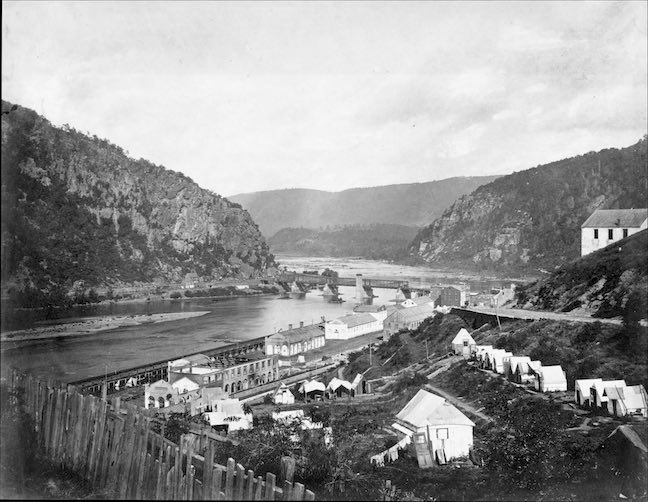| Credit: | by Gardner (James) |
|---|---|
| Date: | 1862.03 |
| Negative Size: | 8 in. x 10 in. |
| Equipment: | wall tent |
| Locations & Lines: | Baltimore & Ohio Railroad (B&O); Bolivar Heights (Harpers Ferry WV); Harpers Ferry WV; Loudoun Heights VA; Maryland ; Maryland Heights MD; US Armory and Arsenal (Harpers Ferry WV); Virginia; West Virginia |
| Military Units: | US Army |
| Structures & Establishments: | B&O Bridge (b) (Harpers Ferry WV) |
| Sources: | Library of Congress; National Archives |
$4.99
File Details: AIKHm, 400 DPI, TIFF, Original Photograph, 9.5 Mb
Image ID: AIKH
Gardners Photographic Sketch Book Of The War. Vol. 1, No. 26. Meeting of the Shenandoah and Potomac at Harpers Ferry. July, 1865. Perhaps no point, North or South, has been the scene of so many changes in the shifting panorama of war, through which we have passed in the last four years, as Harpers Ferry. Situated at the junction of the Shenandoah and Potomac rivers, with the Baltimore and Ohio Railroad passing through it, and surrounded by high mountains and impassable ravines, it was supposed that, in locating a National Armory there, that it would be secure against any assault that could be made by an enemy. First captured by a surprise, John Brown, with seventeen men, held it for nearly three days. When Virginia seceded, the first step taken was to send an officer to seize the armories and arsenals, but orders having been given by the Government to fire them on approach of any hostile force, they were burned by a small body of artillerymen, who retreated to Carlisle, Pa. Thousands of rifles were burned, but a small number of buildings and considerable machinery were saved by the enemy, who subsequently removed the machinery to Richmond and commenced the manufacture of rifles there for the rebel army. It has been held by the confederates three times since then. Once they captured it with an immense amount of stores, artillery, and ten thousand prisoners. In the foreground are a few tents, located for the post garrison. In the centre are eight buildings, what were left of the armory, some of which have been roofed in with boards and used as warehoused for army stores. Passing between the Potomac and the armory buildings is the Baltimore and Ohio Railroad, which crosses upon a high bridge to the Maryland shore. This bridge has been so often destroyed during the last five years that it is estimated that a million of dollars have been spent in keeping it in repair. As the Potomac disappears in the distance it unites with the Shenandoah, which rushes down the gorge by the side of the Loudoun Heights. Upon the left are the Maryland Heights, the natural key to the position. It was here that Col. Ford abandoned his position, and Stonewall Jackson seizing it the next day, compelled a surrender of our forces just before the battle of Antietam. The high brick building at the end of the bridge was a fine hotel, but the confederates subsequently destroyed it. Between it and the row of tents, and not far from the hotel, is located the little engine house used as a fort by John Brown, and which has escaped destruction. It is not probable that the armory and arsenals will ever be rebuilt.

